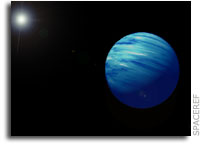Hydrodynamic Simulations of Captured Protoatmospheres Around Earth-like Planets

Young terrestrial planets, when they are still embedded in a circumstellar disk, accumulate an atmosphere of nebula gas.
The evolution and eventual evaporation of the protoplanetary disk affect the structure and dynamics of the planetary atmosphere. These processes, combined with other mass loss mechanisms, such as thermal escape driven by extreme ultraviolet and soft X-ray radiation (XUV) from the young host star, determine how much of the primary atmosphere, if anything at all, survives into later stages of planetary evolution. Our aim is to explore the structure and the dynamic outflow processes of nebula-accreted atmospheres in dependency on changes in the planetary environment.
We integrate stationary hydrostatic models and perform time-dependent dynamical simulations to investigate the effect of a changing nebula environment on the atmospheric structure and the timescales on which the protoatmosphere reacts to these changes. We find that the behavior of the atmospheres strongly depends on the mass of the planetary core. For planets of about Mars-mass the atmospheric structure, and in particular the atmospheric mass, changes drastically and on very short timescales whereas atmospheres around higher mass planets are much more robust and inert.
Alexander Stoekl, Ernst Dorfi, Helmut Lammer
(Submitted on 26 May 2015)
Subjects: Earth and Planetary Astrophysics (astro-ph.EP)
Journal reference: 2015, A&A, 576, 87
Cite as: arXiv:1505.06859 [astro-ph.EP] (or arXiv:1505.06859v1 [astro-ph.EP] for this version)
Submission history
From: Alexander Stoekl
[v1] Tue, 26 May 2015 08:56:44 GMT (120kb)
http://arxiv.org/abs/1505.06859








